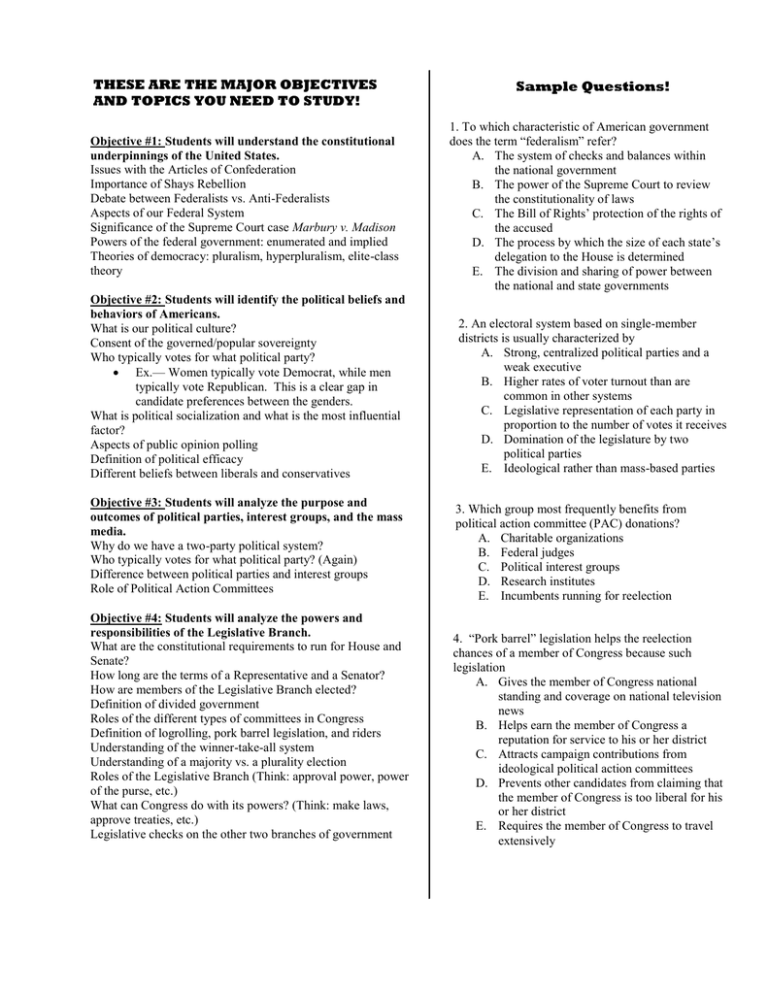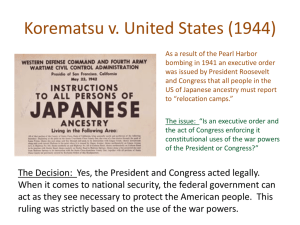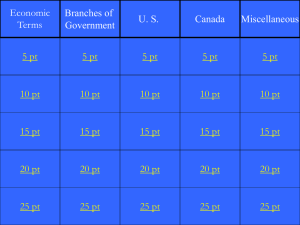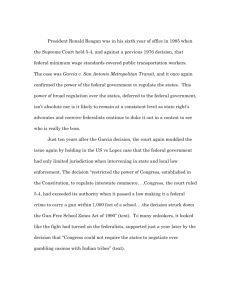Exam Review Document - AP Government and politics
advertisement

THESE ARE THE MAJOR OBJECTIVES AND TOPICS YOU NEED TO STUDY! Objective #1: Students will understand the constitutional underpinnings of the United States. Issues with the Articles of Confederation Importance of Shays Rebellion Debate between Federalists vs. Anti-Federalists Aspects of our Federal System Significance of the Supreme Court case Marbury v. Madison Powers of the federal government: enumerated and implied Theories of democracy: pluralism, hyperpluralism, elite-class theory Objective #2: Students will identify the political beliefs and behaviors of Americans. What is our political culture? Consent of the governed/popular sovereignty Who typically votes for what political party? Ex.— Women typically vote Democrat, while men typically vote Republican. This is a clear gap in candidate preferences between the genders. What is political socialization and what is the most influential factor? Aspects of public opinion polling Definition of political efficacy Different beliefs between liberals and conservatives Objective #3: Students will analyze the purpose and outcomes of political parties, interest groups, and the mass media. Why do we have a two-party political system? Who typically votes for what political party? (Again) Difference between political parties and interest groups Role of Political Action Committees Objective #4: Students will analyze the powers and responsibilities of the Legislative Branch. What are the constitutional requirements to run for House and Senate? How long are the terms of a Representative and a Senator? How are members of the Legislative Branch elected? Definition of divided government Roles of the different types of committees in Congress Definition of logrolling, pork barrel legislation, and riders Understanding of the winner-take-all system Understanding of a majority vs. a plurality election Roles of the Legislative Branch (Think: approval power, power of the purse, etc.) What can Congress do with its powers? (Think: make laws, approve treaties, etc.) Legislative checks on the other two branches of government Sample Questions! 1. To which characteristic of American government does the term “federalism” refer? A. The system of checks and balances within the national government B. The power of the Supreme Court to review the constitutionality of laws C. The Bill of Rights’ protection of the rights of the accused D. The process by which the size of each state’s delegation to the House is determined E. The division and sharing of power between the national and state governments 2. An electoral system based on single-member districts is usually characterized by A. Strong, centralized political parties and a weak executive B. Higher rates of voter turnout than are common in other systems C. Legislative representation of each party in proportion to the number of votes it receives D. Domination of the legislature by two political parties E. Ideological rather than mass-based parties 3. Which group most frequently benefits from political action committee (PAC) donations? A. Charitable organizations B. Federal judges C. Political interest groups D. Research institutes E. Incumbents running for reelection 4. “Pork barrel” legislation helps the reelection chances of a member of Congress because such legislation A. Gives the member of Congress national standing and coverage on national television news B. Helps earn the member of Congress a reputation for service to his or her district C. Attracts campaign contributions from ideological political action committees D. Prevents other candidates from claiming that the member of Congress is too liberal for his or her district E. Requires the member of Congress to travel extensively Objective #5: Students will analyze the powers and responsibilities of the Executive Branch. The role of the Electoral College How do candidates for election win electors in each state? Biggest influence for individual voting habits What are the constitutional powers of the president? What do presidential candidates think about when choosing a VP running mate? What is the job of the federal bureaucracy? What can the federal bureaucracy do after Congress passes a law? What is the major office that deals with budget proposals? What is the significance of a presidential veto? What are the checks of the Executive Branch on the other branches of government? Objective #6: Students will analyze the powers and responsibilities of the Judicial Branch. Who decides the number of Justices on the Supreme Court? What are the formal qualifications for being a federal judge? Importance of federal judges serving during good behavior (Think: Free from some influences of $, campaigns, etc.) Different types of briefs submitted: lawyer briefs and amicus curiae briefs How does the Supreme Court get its cases? What is the most popular way? Different types of jurisdiction and what courts have original vs. appellate Difference between judicial activism vs. judicial restraint Importance of the Supreme Court case of Marbury v. Madison and McCulloch v. Maryland What is the rule of four? Objective #7: Students will identify the public policymaking process, the different types of public policy, and their impact on society. What are the different types of public policy? How is money involved in public policy? Who is involved in the Iron Triangle? What is the impact of federalism on the policies created? Objective #8: Students will analyze the constitutional foundation of civil liberties and civil rights and their historical progress in the three branches of government. Definition of civil liberties Definition of civil rights Civil Rights Act of 1964 and Voting Rights Act of 1965 What is 14th Amendment incorporation? Definition of a write of habeas corpus, bill of attainder, and ex post facto laws Significance of the cases Mapp v. Ohio, Miranda v. Arizona, Roe v. Wade, Gideon v. Wainright, Tinker v. Des Moines A basic understanding of the amendments in the Bill of Rights What Supreme Court case outlaws segregation? What are the restrictions on freedom of speech? 5. Which of the following would result from the direct election of presidential candidates? A. A national primary would be established B. Party nominating conventions would be abolished C. Each vote would count equally in determining which candidate won the election D. The Electoral College would become more influential in the electoral process E. Third Party candidates would have less chance of winning the election 6. Which of the following statements accurately describes the selection of the caseload for the United States Supreme Court? A. The United States Constitution spells out all of the categories of cases that the Supreme Court must hear B. The Chief Justice of the Supreme Court has the authority to select the cases that the court will hear C. The Solicitor General in the Department of Justice determines the Supreme Court’s agenda D. The Supreme Court is free to choose the cases it hears with only a few limitations E. The Attorney General screens cases for consideration by the Court 7. Fiscal federalism is A. The pattern of spending, taxing, and providing grants in the federal system B. The distinct separation of national government spending vs. state spending C. The federal income tax D. A sharing of local and national resources practiced in other countries E. The federal government’s regulation of the money supply and interest rates 8. All of the following statements reflect positions the Supreme Court has taken with regard to the right of free speech EXCEPT: A. A restriction on the right of free speech should always be viewed with skepticism B. There are not acceptable governmental restrictions on free speech C. Government has an obligation to try to ensure citizens the right to be heard D. The right to free speech is a fundamental natural right E. The First Amendment protects free speech from incursions of both the federal and state governments







